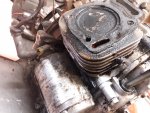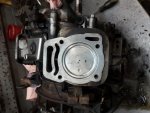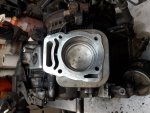Hello all I hope someone can help me out here. I have a B&S 18 HP v-twin model number 350447 type 1331-E1 code 04051311. I bought this on a piece of equipment last May with 2674 Hrs. This machine had sit idle for 5 years. The carb was shot and needed replacement when I purchased it. I cleaned all the mice nests from the cooling fins as well as servicing it. At that time I adjusted the valves according to the service manual and did a compression test. Looking at the engine the right side was 170 psi and the front was 160. The engine ran well for abut 200 hrs with routine maintenance. The engine started having problems first with smoking and it smelled like oil if it was not run every day. First it was a little then a lot. Then after sitting for a while the engine would not start. The battery had a full charge and the starter was checked good according to the service manual. I drained the oil and it was slightly overfilled and came out a grey color and seemed as though it had gas in it. The oil had about 50 hrs on it straight 30wt. I checked the fuel shutoff valve on the carb and it was operational. I checked the compression and the right side of the motor now had 120 psi and the left side had 145. There seemed to be leakage around the head gasket on the right side (low compression side). The air filter was also covered in oil. I removed the heads and installed all new gaskets and torqued all to factory specs. There was also a lot of carbon buildup on the top of the piston on both sides and in the head which I cleaned off with carb cleaner and a fine scrub pad. I checked the sealing of the valves by putting carb cleaner in the head on top of a paper towel. No leakage over night. Torqued everything to factory specs and installed back into machine. Engine fired right up this time no problem and ran good however it still smoked. After checking the compression on both cylinders the right side now had 90psi and the left side now had 150psi. I also checked the head and top of the cylinder mounting service for distortion (.004" or less)
My question to you all is how many hrs is a Briggs vanguard 18hp engine made to run if all factory maintenance schedules are performed?
Has anyone on here rebuilt one of these engines or is it not worth the time. I can buy a replacement B&S engine for $1100.
I have a factory service manual. How do I know what piston I would need to rebuild it? I see there is different sizes available.
Could my engine be repowered by just doing a light hone and rings if there was no scoring on the piston or cylinder skirts?
Is it best to have a briggs dealer do the honing and piston resizing if needed and how much would that cost? Would they even do that anymore?
I see the hone is available (#19205) but not the tool to check the cylinder size anymore (#19404). Does anyone know a replacement to check the cylinder size? The FSM says to measure the cylinder with telescoping tool #19404 and dial caliper #19199 at six points to see if within spec.
Also I do not understand why my right side cylinder compression test went down that much after my disassemble. Did the excess carbon make it raise that much?
Thanks for your help
Sean
My question to you all is how many hrs is a Briggs vanguard 18hp engine made to run if all factory maintenance schedules are performed?
Has anyone on here rebuilt one of these engines or is it not worth the time. I can buy a replacement B&S engine for $1100.
I have a factory service manual. How do I know what piston I would need to rebuild it? I see there is different sizes available.
Could my engine be repowered by just doing a light hone and rings if there was no scoring on the piston or cylinder skirts?
Is it best to have a briggs dealer do the honing and piston resizing if needed and how much would that cost? Would they even do that anymore?
I see the hone is available (#19205) but not the tool to check the cylinder size anymore (#19404). Does anyone know a replacement to check the cylinder size? The FSM says to measure the cylinder with telescoping tool #19404 and dial caliper #19199 at six points to see if within spec.
Also I do not understand why my right side cylinder compression test went down that much after my disassemble. Did the excess carbon make it raise that much?
Thanks for your help
Sean
Last edited:



